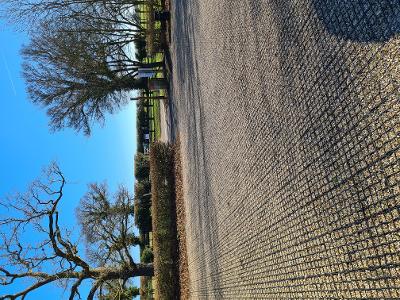Venta Icenorum

Project details
The Venta Icenorum project provided the Greater Norwich Growth Board (GNGB) with a valuable opportunity to address a range of Green Infrastructure (GI) challenges at a Historic England-listed site in Caistor St Edmund. The initiative received £153,128 from the GNGB's Infrastructure Investment Fund (IIF), with additional support from the Norfolk Archaeological Trust (NAT). This funding enabled enhancements to the visitor experience at this GI heritage site, focusing on improved accessibility, increased capacity, enhanced safety, and sustainability.
Venta Icenorum is a popular destination that has historically struggled to accommodate high visitor numbers. The car park frequently reached capacity, resulting in visitors parking on the verge of a small rural road. This situation was causing safety issues, and the police had raised concerns. The site also experienced issues with antisocial behaviour. To address these challenges, and to enhance a popular multifunctional green infrastructure destination, the project delivered the following improvements:
- The car park was upgraded and extended by 2,000m², effectively doubling its capacity. This expansion significantly reduced verge parking and improved safety for road users and the local community.
- A new height-restriction barrier was installed at the entrance to prevent unauthorised overnight access and antisocial behaviour.
- Designated bays for Blue Badge holders were introduced, along with infrastructure to support two new Electric Vehicle charging points.
- New cycle parking bays were added to encourage sustainable travel and reduce pressure on car parking facilities.
- A new oak gazebo was constructed at the site entrance, serving as a meeting point, shelter, and location for interpretive information boards.
These deliverables align with the aims of the Greater Norwich GI Strategy, including the creation and maintenance of a multifunctional GI network and a well-connected system of green spaces. They also support the key GI strategic priorities of enabling access to nature and healthy lifestyles, strengthening distinctive places, and supporting nature recovery.
Caistor Roman Town, as the site is also known, was the largest Roman town in East Anglia, and its remains are still visible today. It is a popular open space attracting between 40,000 and 50,000 visitors annually and is owned by the NAT and managed in partnership with South Norfolk Council (SNC). SNC is responsible for managing public access and visitor facilities, including the car park, while NAT oversees the archaeological elements and areas beyond SNC's remit.
Image Gallery
Location of Venta Icenorum
Link to website and contact details
Website: Caistor Roman Town
Contact: info@norfarchtrust.org.uk
More Green Infrastructure Projects

Cringleford Meadow - Yare Valley Walk

Kett's Country Long Distance Trail

Bure Valley Path
Greater Norwich Growth Board partners




















